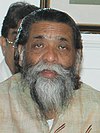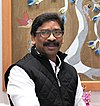Jharkhand Mukti Morcha
Jharkhand Mukti Morcha Jharkhand Liberation Front | |
|---|---|
 | |
| Abbreviation | JMM |
| President | Shibu Soren |
| Chairman | Hemant Soren |
| Secretary | Supriya Bhattacharya |
| Lok Sabha Leader | Vijay Kumar Hansda |
| Rajya Sabha Leader | Shibu Soren |
| Founder | Binod Bihari Mahato, Shibu Soren, A. K. Roy |
| Founded | 15 November 1972 |
| Headquarters | Bariatu Road, Ranchi, Jharkhand – 834008 |
| Student wing | Jharkhand Chhatra Morcha |
| Youth wing | Jharkhand Yuva Morcha |
| Women's wing | Jharkhand Mahila Morcha |
| Ideology | Socialism[1] Regionalism[2] Indigenous rights[3] Left-wing populism[4] |
| Political position | Left-wing[5] |
| Colours | Green |
| ECI Status | State Party[6] |
| Alliance | I.N.D.I.A. (2023–present) Mahagathbandhan (2019–present) UPA (2004–2023)[7] |
| Seats in Lok Sabha | 3 / 543 |
| Seats in Rajya Sabha | 3 / 245 |
| Seats in Jharkhand Legislative Assembly | 34 / 81 |
| Number of states and union territories in government | 1 / 31 |
| Election symbol | |
 | |
| Party flag | |
 | |
Jharkhand Mukti Morcha (lit. Jharkhand Liberation Front; abbr. JMM) is a political party in the Indian state of Jharkhand which was founded by Binod Bihari Mahato.[8] Shibu Soren is the president of the JMM. JMM is also an influential political party in the state of Odisha and parts of neighbouring of states. Its election symbol for Jharkhand is Bow and Arrow.[9]
The party was officially created on the birthday of Birsa Munda, the 19th century tribal warrior of Jharkhand, who fought against the British rule in present-day Jharkhand.[10] The State of Jharkhand also came into existence on Birsa Munda's birthday in 2000.[11]
Formation
[edit]For almost six decades the movement to separate Jharkhand from Bihar had been attempting to gain a foothold. The Jharkhand Party gained political strength but commissions examining the demands for a separate Jharkhand State consistently rejected its demands. Before 1962, the Jharkhand Party held between 23 and 32 seats in the Bihar Legislative Assembly. In 1962, it won 20 seats. Jaipal Singh Munda merged the Jharkhand Party with the Indian National Congress in 1963 and became a minister in Vinodanand Jha's government in Bihar. But other members did not join the Congress.[12]
In the 1967 general election, the party had a very poor showing with only eight Assembly seats. The party soon split into several splinter parties each claiming to be the real Jharkhand Party.[13] These included the Jharkhand Party led by N. E. Horo, the Jharkhand Party led by Naren, and the All India Jharkhand Party led by Bagun Sumroi. There was also the Hul Jharkhand Party led by Justin Richard, which further fragmented and became the Bihar Progressive Hul Jharkhand Party led by Shibu Soren.
Jharkhand Mukti Morcha was founded by Soren, Binod Bihari Mahato and Marxist Co-ordination Committee leader A. K. Roy. The party was officially created on the birthday of Birsa Munda, a 19th-century tribal warrior from Jharkhand, who fought against British rule in the region.[14]
On 4 February 1973, Mahato became president of the party and Soren became its general secretary. Prominent party leaders at that time included Roy, Nirmal Mahto and Tek Lal Mahto, among others.
Early years
[edit]In its early years, the JMM under Soren's leadership brought industrial and mining workers who were mainly non-tribals belonging to the Dalit and backward communities such as Surdis, Doms, Dusadh, Kurmi, Koiri, Gowala, and Teli into its fold. However Soren's association with the late politician Gyanranjan brought him close to the Prime Minister Indira Gandhi. He won the Dumka Lok Sabha seat in 1972. Irked by Soren's association with the Indian National Congress, a few younger members of the JMM banded together in Jamshedpur and set up the All Jharkhand Students Union (AJSU). This did not affect the growth of the JMM in the 1991 Indian general election, where the party won six seats.
Ram Dayal Munda reignited the movement for Jharkhand by unifying splinter groups among the tribals. Under his guidance the Jharkhand Coordination Committee was constituted in June 1987, comprising 48 organisations and group including the JMM factions. Due to Munda, Shibu Soren, Suraj Mandal, Simon Marandi, Shailendra Mahato, and AJSU leaders like Surya Singh Besra and Prabhakar Tirkey briefly shared a political platform, but the JMM pulled out of JCC as it felt that "the collective leadership was a farce". In 1988 and 1989, the JMM, AJSU and JPP successfully orchestrated so-called bandhs, economic blockades.
Jharkhand Yuva Morcha
[edit]Jharkhand Yuva Morcha (Jharkhand Youth Front) and Jharkhand Chhatra Morcha (Jharkhand Student Front), the youth and student wings of Jharkhand Mukti Morcha, were constituted at a conference in Ranchi 16 October 1991.
Electoral Performance
[edit]General election results
[edit]| Election Year | Lok Sabha | Seats contested | Seats won | +/- seats | Overall Votes | Percentage of votes |
|---|---|---|---|---|---|---|
| 1984 | 8th Lok Sabha | 10 | 0 | 332,403 | 0.14 | |
| 1984 | 8th Lok Sabha | 10 | 0 | 332,403 | 0.14 | |
| 1984 | 8th Lok Sabha | 10 | 0 | 332,403 | 0.14 | |
| 1989 | 9th Lok Sabha | 12 | 3 | 1,032,276 | 0.34 | |
| 1991 | 10th Lok Sabha | 14 | 6 | 1,481,900 | 0.54 | |
| 1996 | 11th Lok Sabha | 29 | 1 | 1,287,072 | 0.38 | |
| 1998 | 12th Lok Sabha | 16 | 0 | 1,324,548 | 0.36 | |
| 1999 | 13th Lok Sabha | 23 | 0 | 974,609 | 0.27 | |
| 2004 | 14th Lok Sabha | 9 | 5 | 1,846,843 | 0.47 | |
| 2009 | 15th Lok Sabha | 42 | 2 | 1,665,173 | 0.40 | |
| 2014 | 16th Lok Sabha | 21 | 2 | 1,637,994 | 0.30 | |
| 2019 | 17th Lok Sabha | 13 | 1 | 1,901,976 | 0.31 | |
| 2024 | 18th Lok Sabha | 6 | 3 | 2,652,955 | 0.41 |
Legislative Assembly election results
[edit]| Election Year | Seats contested | Seats won | +/- seats | Overall Votes | Percentage of votes |
|---|---|---|---|---|---|
| 1980 | 11 | 380,891 | 1.69 | ||
| 1985 | 57 | 9 | 443,822 | 1.82 | |
| 1990 | 82 | 19 | 3.14 | ||
| 1995 | 63 | 10 | 2.3 | ||
| 2000 | 12 | ||||
| 2005 | 49 | 17 | 1,447,774 | 14.29 | |
| 2009 | 78 | 18 | 1,562,060 | 15.20 | |
| 2014 | 79 | 19 | 2,832,921 | 20.43 | |
| 2019 | 43 | 30 | 2,817,442 | 18.72 | |
| 2024 | 43 | 34 | 4,183,281 | 23.44 |
List of chief ministers
[edit]| No. | Chief Minister | Portrait | Term in Office | Assembly (election) |
Constituency | ||
|---|---|---|---|---|---|---|---|
| Start | End | Tenure | |||||
| 1 | Shibu Soren | 
|
2 March 2005 | 12 March 2005 | 308 days | 2nd Assembly (2005 election) |
did not contest |
| 27 August 2008 | 19 January 2009 | ||||||
| 30 December 2009 | 1 June 2010 | 3rd Assembly (2009 election) |
Jamtara | ||||
| 3 | Champai Soren | 
|
2 February 2024 | 3 July 2024 | 153 days | 5th Assembly (2019 election) |
Seraikella |
| 2 | Hemant Soren | 
|
13 July 2013 | 28 December 2014 | 6 years | 3rd Assembly (2009 election) |
Dumka |
| 29 December 2019 | 2 February 2024 | 5th Assembly (2019 election) |
Barhait | ||||
| 4 July 2024 | November 2024 | ||||||
| November 2024 | Incumbent | 6th Assembly (2024 election) | |||||
List of Union Ministers
[edit]| No. | Portrait | Minister | Portfolio | Term in Office | Constituency (House) |
Prime Minister | ||
|---|---|---|---|---|---|---|---|---|
| Assumed Office | Left Office | Time in Office | ||||||
| 1 | 
|
Shibu Soren (born 1944) |
Minister of Coal | 23 May 2004 | 24 July 2004 | 62 days | Dumka (Lok Sabha) |
Manmohan Singh |
| 27 November 2004 | 2 March 2005 | 95 days | ||||||
| 29 January 2006 | 29 November 2006 | 304 days | ||||||
| Minister of Mines and Minerals | 23 May 2004 | 24 July 2004 | 62 days | |||||
List of deputy chief ministers
[edit]| No. | Deputy Chief Minister (Constituency) |
Portrait | Term in Office | Assembly (election) |
Chief Minister | |||
|---|---|---|---|---|---|---|---|---|
| Start | End | Tenure | ||||||
| 1 | Sudhir Mahato
(Silli) |
14 September 2006 | 23 August 2008 | 1 year, 344 days | 2nd Assembly (2005 election) |
Madhu Koda | ||
| 2 | Hemant Soren (Dumka) |

|
11 September 2010 | 18 January 2013 | 2 years, 129 days | 3rd Assembly (2009 election) |
Arjun Munda | |
List of leaders of opposition
[edit]| No. | Leader of Opposition (Constituency) |
Portrait | Term in Office | Assembly (election) | ||
|---|---|---|---|---|---|---|
| Start | End | Tenure | ||||
| 1 | Stephen Marandi (Dumka) |
24 November 2000 | 10 July 2004 | 3 years, 229 days | 1st Assembly (2000 election) | |
| 2 | Haji Hussain Ansari (Madhupur) |
2 August 2004 | 1 March 2005 | 211 days | ||
| 3 | Sudhir Mahato (Silli) |
16 March 2005 | 18 September 2006 | 1 year, 186 days | 2nd Assembly (2005 election) | |
| 4 | Hemant Soren (Barhait) |

|
7 January 2015 | 28 December 2019 | 4 years, 355 days | 4th Assembly (2014 election) |
See also
[edit]References
[edit]- ^ Ghosh, Arunabha (1993). "Ideology and Politics of Jharkhand Movement: An Overview". Economic and Political Weekly. 28 (35): 1788–1790. JSTOR 4400070.
- ^ Ghosh, Arunabha (1993). "Ideology and Politics of Jharkhand Movement: An Overview". Economic and Political Weekly. 28 (35): 1788–1790. JSTOR 4400070.
- ^ "Soren writes to Assam chief minister Sarma, seeks ST status for tea tribes".
- ^ Minj, Nolina (26 May 2024). "How Kalpana Soren filled a political void in Jharkhand – with ease". Scroll.in. Retrieved 29 June 2024.
- ^ Ghosh, Arunabha (1993). "Ideology and Politics of Jharkhand Movement: An Overview". Economic and Political Weekly. 28 (35): 1788–1790. JSTOR 4400070.
- ^ "List of Political Parties and Election Symbols main Notification Dated 18.01.2013" (PDF). India: Election Commission of India. 2013. Retrieved 9 May 2013.
- ^ "Congress, JMM seal pre-poll pact in Jharkhand | Ranchi News - Times of India". The Times of India. 6 March 2018.
- ^ "Saffron Munda loves everything green - BJP cries neglect as chief minister warms up to old JMM associates". www.telegraphindia.com.
- ^ Pradeep Kaushal (28 September 2015). "Shiv Sena finds Jharkhand Mukti Morcha has first right to symbol". indianexpress.com. New Delhi: The Indian Express. Retrieved 28 April 2020.
Shivsena's bow-and-arrow symbol is the same as that of the Jharkhand Mukti Morcha.
- ^ P. 522 Lok Sabha debates by India. Parliament. House of the People, India. Parliament. Lok Sabha
- ^ P. 200 Basic Facts of General Knowledge By Sura College of Competition, V.V.K.Subburaj
- ^ Kumāra, Braja Bihārī (1998). Small States Syndrome in India. Concept Publishing Company. ISBN 9788170226918.
- ^ "Separate state yet to fulfil aspirations of tribals". The Times of India. 5 August 2013. ISSN 0971-8257. Retrieved 4 July 2024.
- ^ P. 522 Lok Sabha debates by India. Parliament. House of the People, India. Parliament. Lok Sabha
